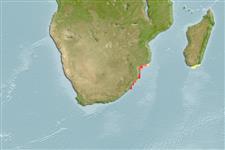>
Gobiiformes (Gobies) >
Gobiidae (Gobies) > Gobiinae
Eponymy: Dr John Frederick Croil Morgans was a research assistant at the Zoology Department of the University of Cape Town. [...] (Ref. 128868), visit book page.
More on author: Smith.
Environment: milieu / climate zone / depth range / distribution range
Ökologie
seewasser; süßwasser; brackwasser demersal; amphidrom (Ref. 46888); tiefenbereich 1 - 16 m (Ref. 28077). Subtropical; 25°S - 31°S
Africa: coastal lakes and estuaries in KwaZulu-Natal, South Africa, and southern Mozambique (Ref. 2798, 52193); also recorded from Madagascar (Ref. 4343).
Length at first maturity / Size / Gewicht / Alter
Maturity: Lm 3.0 range ? - ? cm
Max length : 6.4 cm TL Männchen/unbestimmt; (Ref. 52193)
Rückenflossenstacheln (insgesamt) : 6; Rückenflossenweichstrahlen (insgesamt) : 11 - 12; Afterflossenstacheln: 0; Afterflossenweichstrahlen: 12.
Lives in burrows excavated in clean sand, often in association with the sandprawn Callianassa kraussi (Ref. 52193). Restricted to sandy, quiet water areas and is unable to form burrows where the substrate is disturbed by water movements, is muddy or consists of sand with a particle diameter > 0.5 mm (Ref. 28077). Food consists of slow moving benthic organisms like chironomid larvae, gastropods, bivalves and amphipods (Ref. 28077). Breeds throughout summer, males are territorial (Ref. 52193). On exposed shores, they occur deeper than 3.5 m (Ref. 28077, 2798). Occasionally intertidal.
Life cycle and mating behavior
Geschlechtsreife | Fortpflanzung | Ablaichen | Eier | Fecundity | Larven
Skelton, P.H., 2001. A complete guide to the freshwater fishes of southern Africa. Cape Town (South Africa): Struik Publishers, 395 p. (Ref. 52193)
IUCN Rote Liste Status (Ref. 130435: Version 2024-1)
Bedrohung für Menschen
Harmless
Nutzung durch Menschen
Tools
Zusatzinformationen
Download XML
Internet Quellen
Estimates based on models
Preferred temperature (Ref.
123201): 23.6 - 25.1, mean 24.9 °C (based on 35 cells).
Phylogenetic diversity index (Ref.
82804): PD
50 = 1.0000 [Uniqueness, from 0.5 = low to 2.0 = high].
Bayesian length-weight: a=0.00724 (0.00339 - 0.01546), b=3.10 (2.92 - 3.28), in cm total length, based on LWR estimates for this (Sub)family-body shape (Ref.
93245).
Trophic level (Ref.
69278): 3.3 ±0.45 se; based on food items.
Widerstandsfähigkeit (Ref.
120179): hoch, Verdopplung der Population dauert weniger als 15 Monate. (Preliminary K or Fecundity.).
Fishing Vulnerability (Ref.
59153): Low vulnerability (10 of 100).
